El Salvador is a destination rich in both geography and culture. Sitting in the heart of the Central America region, this small country boasts incredible national parks, long stretches of beautiful beaches, a plethora of inland attractions, and relatively lax visa requirements. Despite retaining its dated reputation for being an unsafe country, El Salvador is actually one of Central America’s safest countries and best places to visit.
With its violent civil war over two decades in the past, visitors of all backgrounds and interests are quickly discovering the array of attractions this country has to offer. Among the long list of destinations, are the following 15 places in El Salvador you should visit in El Salvador:

San Salvador is El Salvador’s capital city. Located in the central plateau region, it is the second largest city in all of Central America (second to Guatemala City.) Despite its colossal size, visitors are generally surprised to find laid back locals, an easy going atmosphere, and a relatively slow pace to the city. Infrastructure, though on the mend since the millennium, is still hit or miss, with earthquakes and war showing their scars throughout the city.
If you’re interested in connecting with the local culture, you might want to learn some of their slang words used by the residents, as it can be a fun way to immerse yourself in the city’s unique vibe.
Check out Things to See and Do in San Salvador
From the crumbling remains of original Spanish colonial architecture to the large gap between rich and poor, San Salvador has a long road ahead. There is still violence in the city, however it’s mostly concentrated in the poorest neighborhoods, far from the tourist sectors, where inter-gang violence is high.

One of the most unique aspects about San Salvador is its location. Despite being the country’s largest metropolis, visitors are only minutes away from awe-inspiring natural beauty. From gorgeous volcanoes and the stunning crater lake to some of the best parks in the country, natural beauty is always just around the corner. With San Salvador being a maximum of four hours from any destination in the country, it makes for a great home base when exploring El Salvador.

Two hours northwest of San Salvador, La Palma is famous for being the town where national artist Fernando Llort taught. Utilizing bright colors, childish images, and religious themes, Llort captured the hearts of the El Salvadoran people, making La Palma a nationally recognized artistic hub. Even today the vast majority of its residents make a living by practicing Llort’s artistic style.
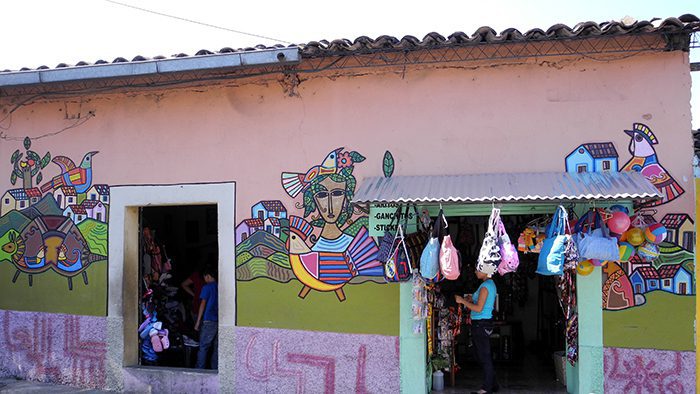
Due to its close proximity to the Honduran border, many visitors choose only to stay in La Palma for convenience purposes. With a vast array of galleries and workshops however, visitors should definitely spend some time soaking in the town’s beautiful artistic heritage. From wall paintings and town murals to workshops, quaint Llort-inspired souvenirs, and the mosaic Central Park, a visit to La Palma is definitely worth the stop.
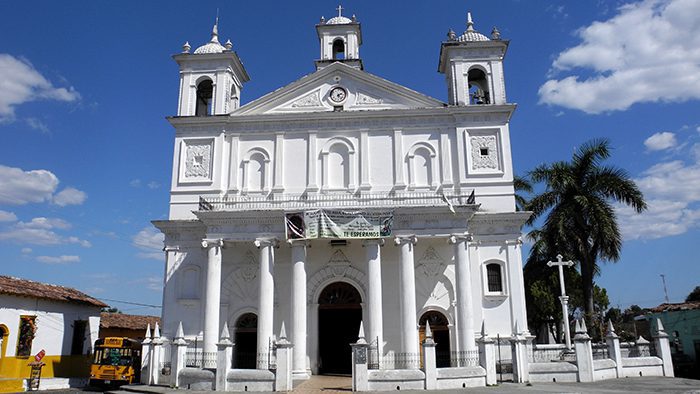
Suchitoto is amongst the few towns in El Salvador that still retain its colonial architecture. Offering a laid-back ambiance, beautiful panoramic views, and quaint cobblestoned streets, this town is one of the country’s most charming. One of Suchitoto’s most popular sites is the Museo de los Recuerdos Alejandro Cotto (admission 4$). Here visitors can explore beautiful grounds, colonial architecture, great views, and classic fountains. Also boasting one of the country’s most impressive art collections, this museum (open daily) is like a town in and of itself!

For those seeking a dose of the outdoors, head for the 39-foot Los Tercios Waterfall, the hot springs of Agua Calienter (2.5 miles further down the road), or the nearby tourist-friendly towns of Palo Grande, El Sitio, and La Mora— all rich in natural beauty.

Joya de Cerén is an extraordinarily well preserved Mayan village. The village was abandoned in a hurry as residents fled the eruption of Laguna de Caldera in 640 A.D. The town was buried in volcanic ash, leaving the city hidden, but intact. It wasn’t until 1976 that Joya de Cerén was discovered.

The second-largest city in El Salvador, Santa Ana offers visitors an urban appeal with a slightly more tranquil environment when compared to San Salvador. Its early 20th-century neo-Gothic cathedral, elaborately decorated theatre, and picturesque main square (Parque Libertad) have won the attention of tourists, making Santa Ana a (more than) worthwhile day trip.
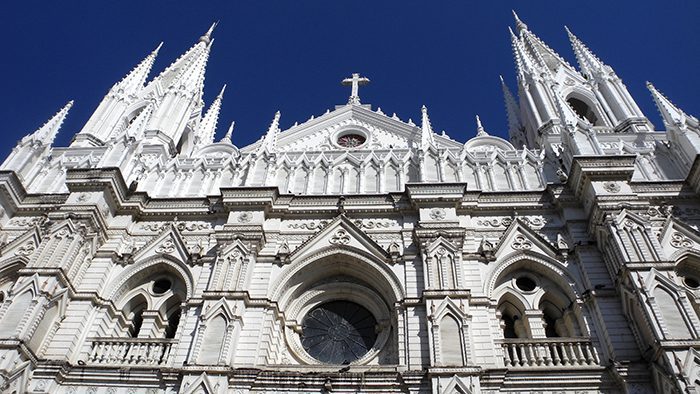
For those seeking a more in-depth experience in Santa Ana, the aforementioned theatre (Teatro de Santa Ana) is a stunning visit both inside and out, and still holds the occasional live performance. If you’re a lover of the arts, be sure to check its schedule when in town!

Founded around 400 A.D., Tazumal is a cluster of unusual step pyramids, the tallest reaching up to 75 feet in height (the largest in the country.) Its autonomous status lasted until Spanish forces moved into El Salvador in the 1520s, after which the local people were conquered and exploited.

The on-site Stanley H. Boggs Museum is a fascinating visit, displaying artifacts uncovered during the excavation. From incense burners to pottery and statues, the remains uncovered by Boggs are a small glimpse into Tazumal’s past.
Check out The Best Mayan Ruins in El Salvador
Perhaps the most notable item in the museum is the Stone of Victories statue— an artifact that provides rare evidence of a connection between modern-day El Salvador and what is now Veracruz, Mexico.

Lago de Coatepeque, or Caldera Coatepeque, is a lake located in the heart of a volcanic crater. At 10 miles in diameter, it’s one of the largest lakes in El Salvador. Formed nearly 72,000 years ago by a series of violent eruptions and volcanic collapses, what remains today is one of the country’s most beautiful natural sites.

Pristine waters make the ideal conditions for swimming, and a range of water sports are available from jet skiing and scuba diving to fishing and aquatic bicycling. Other lake activities include a ferry ride to Teopan Island (in the lake’s center), motorboat excursions, and lake tours, running from 20$/half hour to 50$ for full lake tours. Admission to the lake itself is free.
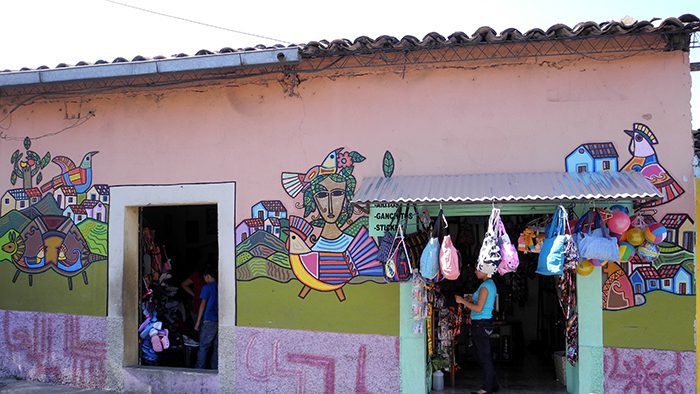
While this park is home to three magnificent volcanoes (Izalco, Santa Ana Volcano hike, and Cerro Verde), the latter (and its namesake) is generally considered the most popular. Boasting one of the country’s few ‘cloud forests’ and a great hiking trail, visitors should plan for a (minimum) one-day visit to this national park. The hike, or La Ventana a la Naturaleza (Window to Nature trail), brings visitors through the oldest forest in the park, going directly through the crater and passing century-old trees along the way. Also home to some brilliant flora and fauna, guided bird watching, horseback riding tours, and great views of the other two volcanoes, a visit to this park is unforgettable.

While Cerro Verde hasn’t erupted in over 2,500 years, the other two have a long history of eruptions. Izalco was once considered the “Lighthouse of the Pacific,” for its 200-straight years of eruptions (until the 1960s.) Santa Ana, ironically one of the most popular climbs in the country, is the most active of the three, with steam constantly rising from one of its craters’ sulfurous lagoons. Park fees are 1$ and local guided tours are highly recommended.
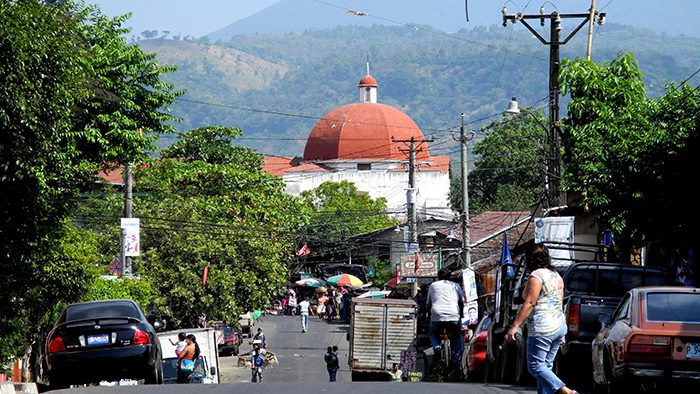
La Ruta de las Flores is a 20-mile mountainous road beginning out of Sonsonate. Its namesake (Route of Flowers) comes from seasonal bursts of flowers (October-February) that dot the side of the road.
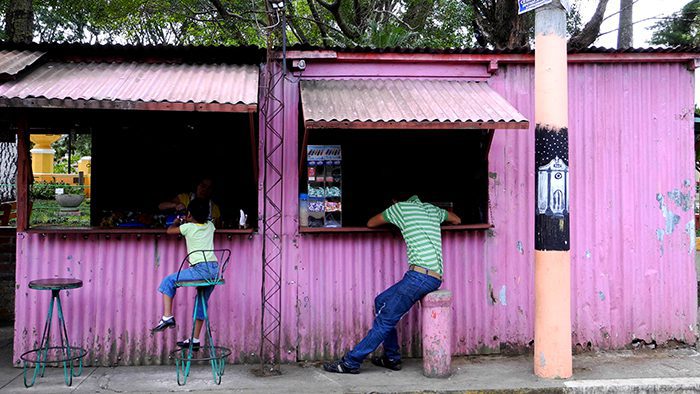
A great side trip for those looking to escape the coastal “surfer scene,” the route is known not only for its floral bursts, but also for the charming colonial towns, lagoons, and waterfalls that dot its 20-mile stretch.
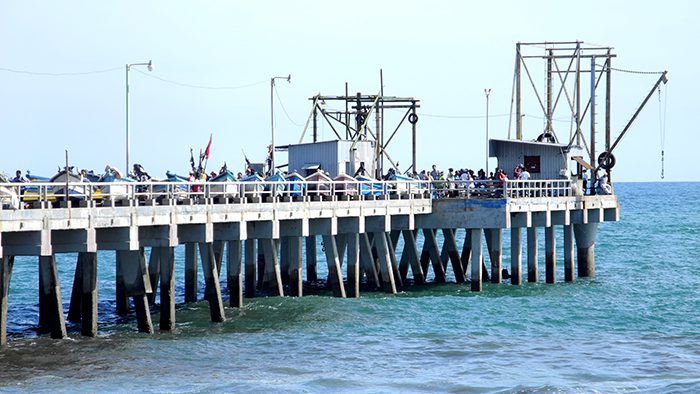
La Libertad (Freedom) is a small port named after El Salvador’s independence from Spain. It offers a quaint port (25 cent entrance fee), and some of the best beaches in El Salvador for shore angling and surfing (Playa La Paz). For those who want to get on the waters, reasonably priced fishing day trips can be organized with local boat captains.
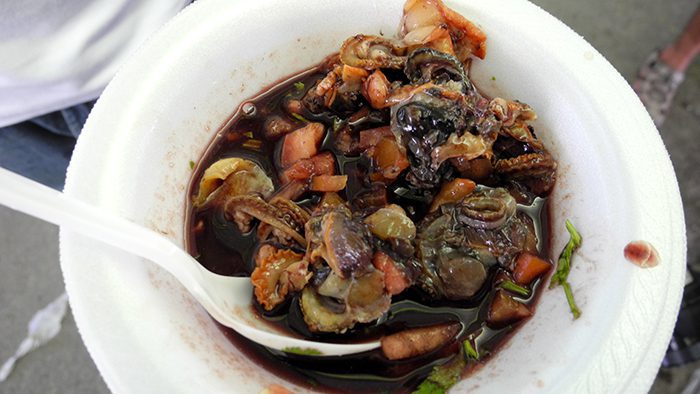
If there’s one thing La Libertad is most famous for, it’s the ceviche. A seafood dish of raw fish “cooked” in lime juice and tossed with spicy pepper and onion… it’s an absolute must-try!
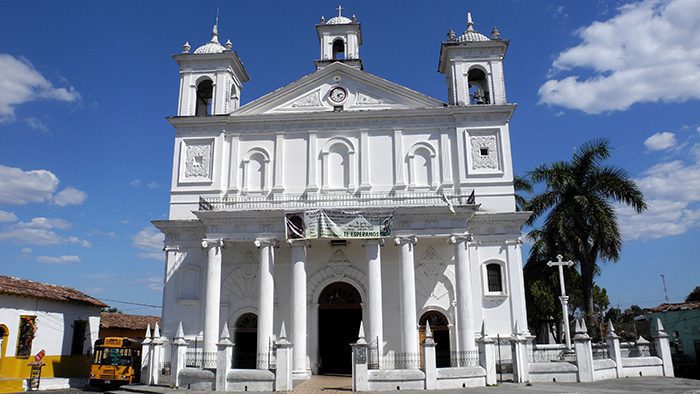
A sandy beach just 30 minutes from San Salvador airport, Costa del Sol is becoming an increasingly popular tourist spot. Divided into three sections (San Marcellino, Los Blancos and Costa del Sol), this wide beach is popular for sporting events, vacationing tourists & locals, and all-inclusive retreats.

One of the highlights of the area is a mangrove boat tour of the Jaltepeque estuary. Located at kilometer 56, this is a protected area home to various bird and fish species. A three-hour boat ride from La Puntilla will take you through mangrove tunnels and where the country’s longest river, Rio Lempe, meets the Pacific Ocean.
Check out The Best Beaches in El Salvador
Another popular attraction in this highly touristic area is the Atlantis water park. Activities include slides, swimming pools, and floating rides.
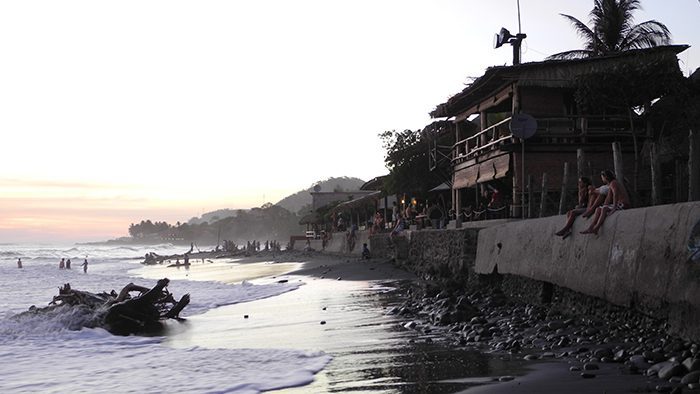
El Tunco is one the most popular of the northern coastal towns for tourists. Named after the “pig-shaped” rock located off its coast, it’s a craggy, powerful region not conducive to swimming… but a surfer’s dream come true. For those looking to hit the waters, surf classes and board rentals are available through local surf shops.
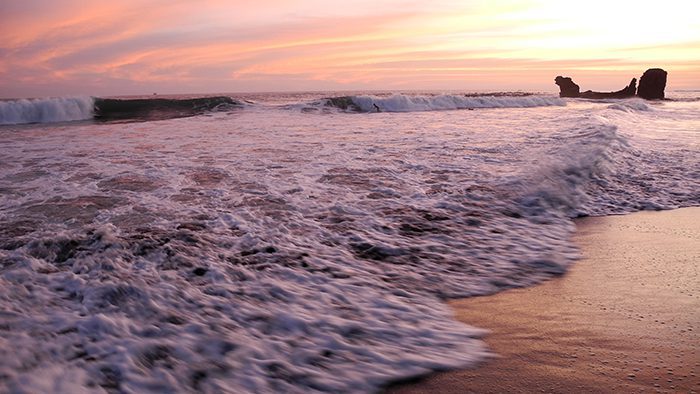
Because El Tunco is such a popular tourist spot, it’s also it’s a great place to meet other travelers and exchange stories. It offers plenty of boutique shops, restaurants, and cafés, as well as a plethora of entertainment options. One of the best nightlife scenes on the northern coast, just ask your hotel’s front desk for the best places to go when you are in town.

The country’s third largest and most populated city, San Miguel is a popular, though slightly less developed, tourist destination. Its historical downtown offers some noteworthy landmarks, from the 19th century Cathedral and Francisco Gavidia Theatre to the San Miguel Market and bustling Avenida Roosevelt (great nightlife!)
Check out the Fab 4 Beers of El Salvador
Hugging the country’s small eastern coast, it also offers close proximity to several beach towns boasting some of Central America’s best surf. A major center of trade, San Miguel’s coastal locale also provides some of El Salvador’s highest quality seafood. One of the hottest destinations in the country… remember to wear cool clothing as summer temperatures reach 109 degrees Fahrenheit!
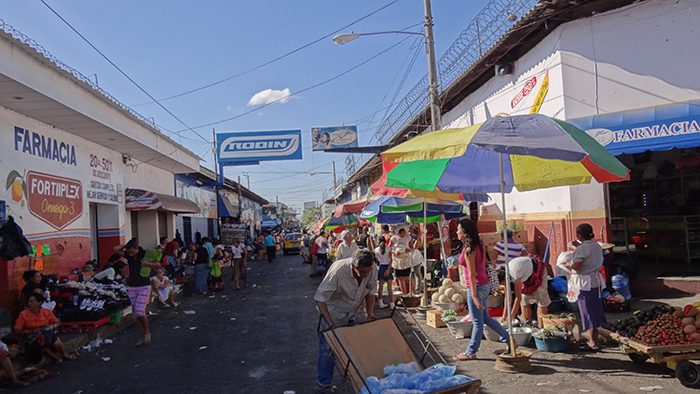
Beyond surfing, several other outdoor sports are available around the city. The nearby San Vicente volcano in El Salvador offers some of the country’s most challenging trail-less hikes (guides are recommended- available through the town’s Mayor’s Office) and the highly active San Miguel Volcano offers breathtaking views… however hikes should not be done without a credible guide due to reports of bandits on the mountain. Lake Olomega, another of the country’s largest, provides a less strenuous visit, with casual nature treks and local boating tours available.
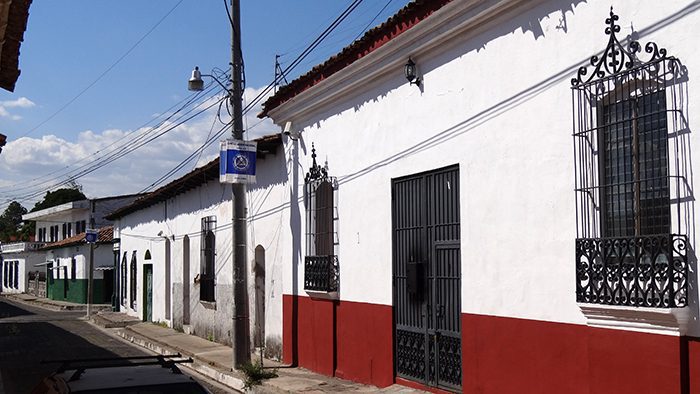
Easily accessible via bus from San Miguel, Playa El Cuco is a beach town offering vendor huts, seafood restaurants, and a shaggy palm-lined shore. The waters are calmer than some of the nearby surfer towns, making it a better option for those interested in swimming.
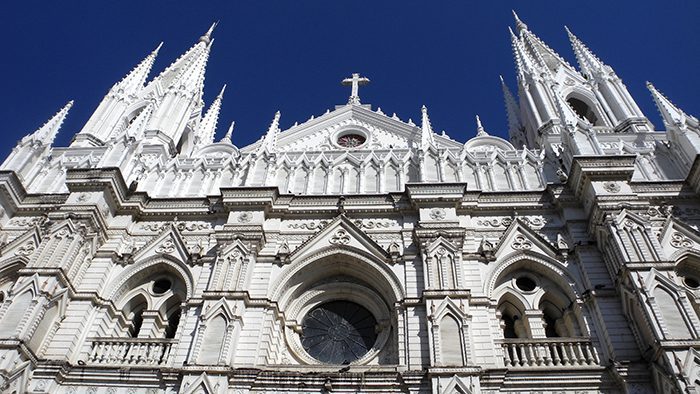
El Cuco is popular is amongst vacationing Salvadorans since the wide shores make it perfect for beach sports such as volleyball and soccer. If you are interested in staying over, we recommend the Hotel Miraflores, located on a cliff with incredible views of Nicaraguan mountains, nearby volcanoes, and, of course, the Pacific Ocean.

Ruta de Paz, or Path of Peace, is a popular tourist itinerary that winds through the area hit hardest by the civil war. Visitors will encounter beautiful mountains and quaint colonial towns, with three main stops along the route (San Fernando, Arambala, and Perquín.) The path itself is located in the department of Morazán, which was the former hub of the guerrillas. Highly damaged during the war, Morazán still remains quite underdeveloped. However, as tourists take an increasing interest in this tumultuous yet naturally stunning area, the status is slowly changing.

Among its three stops, Perquín is the most popular (it also has the most accommodation.) The capital of the revolution and heart of the rebel resistance, the town’s center houses the Museo de la Revolución.
Five rooms display artifacts and war memorabilia, there’s an interactive reconstructed guerrilla display, and many of the guides are ex-guerrillas… so their poignant experiences/stories are well worth hearing. Just down the road, locals occupy what was once a guerrilla camp; for an extra $1 visitors can wander into the tunnels for a unique experience that offers insight into the rugged life of the guerrilla fighters.
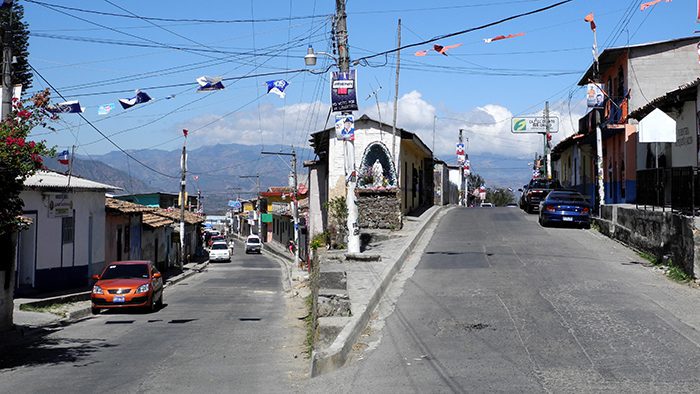
While smaller than the state of Massachusetts, El Salvador condenses a brilliant amount within its borders. Framed by the Pacific, Honduras, and Guatemala (Unesco World Heritage Site), visitors will have everything from surf, sun and sand to active volcanic hikes, cascading waterfalls, and amazing wildlife to explore.
When it comes to visiting El Salvador, timing can be the most challenging aspect. The rainy season (May to October) offers lush beauty, cooler temperatures, and nature at its finest… while the dry season boasts the perfect weather for the beach. Between the food, people, culture, natural and manmade marvels however, El Salvador will not disappoint… regardless of when you visit!
Official name: Republic of El Salvador
Time zone: GMT -6
Language: Spanish
Currency: U.S. Dollar ($)
Currency converter: XE
Getting around: Getting around El Salvador is easy. The majority of the country is easily navigated through a series of inner city and national bus routes. Though buses may seem overwhelming because they are rarely labeled clearly and the stations are chaotic, it’s very easy to figure out by communicating with the locals. Most bus operators will try to hustle you onto their bus, so be sure to double check its destination with someone else before boarding.
Many people planning to venture outside of the major cities opt to rent cars for the sake of convenience which isn’t a bad option so long as you fork out the extra cash for secure parking. The country’s newly constructed road system and well-marked signage makes it fairly east to navigate.
In the larger cities such as San Salvador, Santa Rosa, and San Miguel, taxis are easily hailed on the street. Acacya Taxis and Metro Taxi are two dependable taxi companies that have been around for a long time. Smaller towns will usually have small moto-taxis (tuk-tuks) in lieu of taxis. With rates of approximately 10¢ per block, they are considerably less expensive than regular taxis.
Shopping: In San Salvador everything can be found from local markets to giant shopping centers. San Benito and Paseo Escalón are two high-end shopping areas in the San Salvador’s district of La Zona Rosa. This area is also home to, a classy shopping center with decadent dining options.
In local markets and artesian shops all over the country visitors can find pottery, local indigenous styled paintings, jewelry, textiles and handmade furnishings. Located in the center of San Salvador and open seven days a week is El Mercado Ex-Cuartel, a reasonable site for buying economically priced souvenirs.
When leaving San Salvador, handicrafts are best shopped for along the small pueblos of La Ruta de Las Flores since the coastal towns tend to have lesser quality goods at higher prices since the products are many times brought from other regions. For those looking to do their own grocery shopping, Super Selectos has several locations throughout the country.
When going to small beach towns, it is wise to buy groceries before leaving a major city since prices tends to skyrocket while the availability of many goods will decrease.
Hours of operation: Business hours usually run from 8 a.m. to noon and from 2 p.m. to 4 or 5 p.m. during weekdays and 8:30 a.m. to noon on Saturdays. Most businesses are closed Sunday. Many national tourist sites are open Sunday but closed Monday.
Tips: A 10% tip is customary at restaurants and bars. Some places may automatically include tip on the bill, so it is always a good idea to double-check.
Electricity: 110 volts AC, 60 Hz (same as United States) however, three-prong outlets are not always available so it is best to bring a three-to-two prong adapter for American electrics.
Airport:
International Airport El Salvador (SAL)
+503 2339 9455
Entry requirements: Valid passport, and according to your home country, a $10 tourist visa may need to be purchased upon arrival, which is valid up to 90 days
Best time to go: October through April
NOTE: Need information about which travel documents you need for your next international trip? Check out my essential travel documents guide!
Have you visited any of the 15 places you should visit in El Salvador? Leave us a comment below!
Counter
101 Countries • 1432 Cities
Britney Fuentes says:
Recently spent the whole month of December in El Salvador and it was amazing. In my opinion the best time to go is December. Throughout that month they have a 23 day celebration to celebrate towns with free music and bands. Prices are extremely low compared to the norm in the U.S., a decent meal can range from $1- $7 , drinks included, and maybe an extra entree. Bahia Del Sol, is a great place to stay at, Decameron is amazing as well. San Miguel is a great city, so is La Union. Hiking is great there because of the amazing views and sights. The people are so sweet. Going to El Salvador made me value all I have in life. Tip is never necessary there, but honestly with a $5 tip they can do so much. I just had a great time, don’t let the stereotypes keep you away from such a beautiful country.
Yanik Belliveau says:
Booked a flight for late Jan 2018, in some of the beach town I’m not finding much hostels on hostelworld. Any suggestions?
Didn’t think prebooking was necessary but might be wrong.
Good job David!
Ana Vanegas says:
It’s interesting to know of all those great places to visit, my friend and I are planning a trip to El Salvador in the near future, after reading about the nice places to go,we are very motivated to visit. Thanks for this wonderful information.